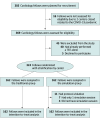Effectiveness of Simulation-Based Training on Transesophageal Echocardiography Learning: The SIMULATOR Randomized Clinical Trial
- PMID: 37070491
- PMCID: PMC12278767
- DOI: 10.1001/jamacardio.2022.5016
Effectiveness of Simulation-Based Training on Transesophageal Echocardiography Learning: The SIMULATOR Randomized Clinical Trial
Abstract
Importance: Evidence is scarce on the effectiveness of simulation-based training in transesophageal echocardiography (TEE).
Objective: To assess the effectiveness of simulation-based teaching vs traditional teaching of TEE knowledge and skills of cardiology fellows.
Design, setting, and participants: Between November 2020 and November 2021, all consecutive cardiology fellows inexperienced in TEE from 42 French university centers were randomized (1:1; n = 324) into 2 groups with or without simulation support.
Main outcomes and measures: The co-primary outcomes were the scores in the final theoretical and practical tests 3 months after the training. TEE duration and the fellows' self-assessment of their proficiency were also assessed.
Results: While the theoretical and practical test scores were similar between the 2 groups (324 participants; 62.6% male; mean age, 26.4 years) before the training (33.0 [SD, 16.3] points vs 32.5 [SD, 18.5] points; P = .80 and 44.2 [SD, 25.5] points vs 46.1 [SD, 26.1] points; P = .51, respectively), the fellows in the simulation group (n = 162; 50%) displayed higher theoretical test and practical test scores after the training than those in the traditional group (n = 162; 50%) (47.2% [SD, 15.6%] vs 38.3% [SD, 19.8%]; P < .001 and 74.5% [SD, 17.7%] vs 59.0% [SD, 25.1%]; P < .001, respectively). Subgroup analyses showed that the effectiveness of the simulation training was even greater when performed at the beginning of the fellowship (ie, 2 years or less of training) (theoretical test: an increase of 11.9 points; 95% CI, 7.2-16.7 vs an increase of 4.25 points; 95% CI, -1.05 to 9.5; P = .03; practical test: an increase of 24.9 points; 95% CI, 18.5-31.0 vs an increase of 10.1 points; 95% CI, 3.9-16.0; P < .001). After the training, the duration to perform a complete TEE was significantly lower in the simulation group than in the traditional group ( 8.3 [SD, 1.4] minutes vs 9.4 [SD, 1.2] minutes; P < .001, respectively). Additionally, fellows in the simulation group felt more ready and more confident about performing a TEE alone after the training (mean score, 3.0; 95% CI, 2.9-3.2 vs mean score, 1.7; 95% CI, 1.4-1.9; P < .001 and mean score, 3.3; 95% CI, 3.1-3.5 vs mean score, 2.4; 95% CI, 2.1-2.6; P < .001, respectively).
Conclusions and relevance: Simulation-based teaching of TEE showed a significant improvement in the knowledge, skills, and self-assessment of proficiency of cardiology fellows, as well as a reduction in the amount of time needed to complete the examination. These results should encourage further investigation of clinical performance and patient benefits of TEE simulation training.
Trial registration: ClinicalTrials.gov NCT05564507.
Conflict of interest statement
Figures




Comment in
-
Jump-starting the Journey to Transesophageal Echocardiogram Mastery.JAMA Cardiol. 2023 Mar 1;8(3):256-257. doi: 10.1001/jamacardio.2022.5030. JAMA Cardiol. 2023. PMID: 36630126 No abstract available.
References
MeSH terms
Associated data
LinkOut - more resources
Full Text Sources
Medical

